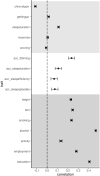Correlations in sleeping patterns and circadian preference between spouses
- PMID: 37957254
- PMCID: PMC10643442
- DOI: 10.1038/s42003-023-05521-7
Correlations in sleeping patterns and circadian preference between spouses
Abstract
Spouses may affect each other's sleeping behaviour. In 47,420 spouse-pairs from the UK Biobank, we found a weak positive phenotypic correlation between spouses for self-reported sleep duration (r = 0.11; 95% CI = 0.10, 0.12) and a weak inverse correlation for chronotype (diurnal preference) (r = -0.11; -0.12, -0.10), which replicated in up to 127,035 23andMe spouse-pairs. Using accelerometer data on 3454 UK Biobank spouse-pairs, the correlation for derived sleep duration was similar to self-report (r = 0.12; 0.09, 0.15). Timing of diurnal activity was positively correlated (r = 0.24; 0.21, 0.27) in contrast to the inverse correlation for chronotype. In Mendelian randomization analysis, positive effects of sleep duration (mean difference=0.13; 0.04, 0.23 SD per SD) and diurnal activity (0.49; 0.03, 0.94) were observed, as were inverse effects of chronotype (-0.15; -0.26, -0.04) and snoring (-0.15; -0.27, -0.04). Findings support the notion that an individual's sleep may impact that of their partner, promoting opportunities for sleep interventions at the family-level.
© 2023. The Author(s).
Conflict of interest statement
R.C.R. is an Editorial Board Member for
Figures




References
-
- Kocevska, D. et al. Sleep characteristics across the lifespan in 1.1 million people from the Netherlands, United Kingdom and United States: a systematic review and meta-analysis. Nat. Hum. Behav.10.1038/s41562-020-00965-x (2020). - PubMed
Publication types
MeSH terms
Grants and funding
LinkOut - more resources
Full Text Sources

